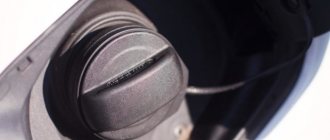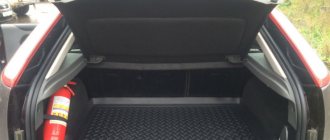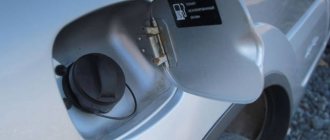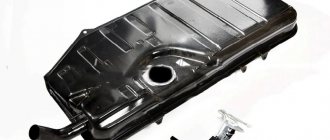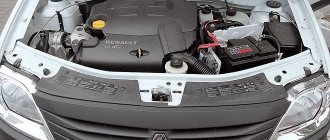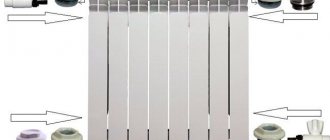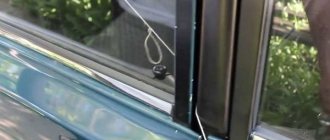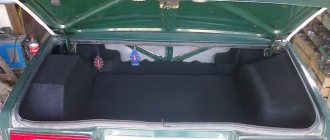Many motorists are familiar with the situation when the fuel tank cap refuses to open. Such a small thing, which few car owners pay attention to, can cause serious inconvenience if it is impossible to open it, especially if this happened right at a gas station, while the car has an empty gas tank. At such moments, some motorists manage to achieve their goal in various ways, showing incredible ingenuity, while others, on the contrary, may panic, especially if the service is far away.
The gas tank flap often does not open in cold weather, but trouble also happens in warm weather. Despite all the working order of the mechanisms that drive the vehicle, the car will go nowhere until it is refueled, so if such a problem arises, you will have to take measures to eliminate it. Depending on the reason that provoked the situation, different ways to resolve the issue are used.
Detailed classification of gas tank caps
The motorist must understand that the cap is not just an element that blocks access to the tank. In a modern car, it also performs a number of other functions: it stabilizes the pressure inside the fuel tank, isolates gasoline or diesel fuel from the negative influence of the external environment, etc.
The fuel tank cap is an important functional element of the car.
The design of the element depends directly on the shape of the neck of the fuel tank. To the greatest extent, everything is determined by the diameter of the thread and the type (it can be external and internal). The depth of entry of the lid into the neck, volume, etc. also matters.
The cover material is always selected taking fire safety into account. This is especially important for cars equipped with gasoline systems. This type of fuel tends to explode under excessive pressure and is more sensitive to the effects of vapors.
Structurally, covers are divided into several types:
- The first option is the simplest. The lid is equipped with a single function - isolating the fuel liquid from the atmosphere.
- The second option is a complex system equipped with valves. The latter ensure stability of pressure inside the tank.
- Lids with lock. In addition to their basic functions, they protect the fuel tank from unauthorized entry.
- Models with memory. Such covers are specially designed for forgetful motorists; they are connected to the tank neck or hatch with a chain.
The cover with a plastic holder or chain is specially designed for forgetful car owners
In addition, covers are classified according to the type of locking mechanism:
- bayonet type, which close by changing the angle;
- threaded;
- shut-off, like on metal cans.
Bayonet and threaded caps are most often used. The first ones are easier to close and open, but they are rarely installed on passenger cars, mostly for tractors and trucks.
Threaded caps can be either internal or external threaded. The difference is in the location of the main and counter threads on the neck of the tank or the cylindrical surface of the lid.
Covers are also divided according to ventilation parameters:
- Valveless models are installed in fuel tanks that have autonomous systems for stabilizing pressure and capturing fuel vapors.
- Single-valve lids are equipped with tanks in which only a fuel vapor recovery system is used, but there is no separate stabilization system.
- Finally, lids with two valves are installed on tanks without autonomous systems. Their purpose is to stabilize the pressure when the gasoline level drops and to release fuel vapors.
Single-valve lids are most common these days. This is due to the design features of modern car models, equipped only with an autonomous fuel vapor recovery system.
Covers are also classified according to the type of theft protection:
- Standard options that do not have any protection.
- Models with a padlock suspended on special brackets.
- Lids with a conventional lock, the cylinder of which is vertically built-in.
- Code caps.
- Models with a lock that can be opened with the ignition key of a specific vehicle.
Standard covers have become more common because they are easy to install. However, recently there has been a demand for lids with combination locks. The padlock is practically out of use today. And covers with a lock that can be opened with the ignition key are found on some top foreign cars.
Fuel tank caps can also be classified according to the presence of additional components:
- with chain or plastic connector;
- with a special grooved handle for easy opening.
And finally, they can be metal or plastic, universal or designed for one car model.
How to open different lid models
Fuel tank caps can open in different ways. As a rule, this is easy to do on domestic cars, but on foreign cars it is much more difficult. To open the code hatches, you have to set the required ratio of numbers. In a word, as many models as there are so many ways of opening.
- A hatch that opens by pressing the corresponding button in the cabin. It is located either on the driver's side door or on the armrest.
The gas cap control button is located on the driver's door
- A cover that can be opened using a standard remote control for the central locking system. In this case, the hatch wiring is paralleled with the door locks.
- A version of the hatch that opens with a lever with a picture of a gas station. The lever, like the button, is located on the threshold of the driver's door.
- Simple lids open by lightly pressing them until they click. Then, holding the notch, you need to pull the hatch towards you.
The lid with a recess opens by pulling towards you
Defrosting the lock
A less common problem is when the filler cap lock itself freezes. To protect the fuel in the gas tank, drivers install special locking mechanisms. Such a “surprise” cap can play a cruel joke on the owner during refueling. The lock is opened in two ways: by defrosting with special liquids or by heating. In the first case, they spray anti-freeze inside the mechanism, wait a few minutes and try to turn the key. If the attempt fails, repeat the procedure.
When you don't have liquid on hand to defrost the locks, you can heat the entire lid or just the locking mechanism. The first option involves the same manipulations as with heating the hatch. If you don’t have the necessary tool at hand, you can defrost the lock using a key. It is heated with a lighter or matches, then inserted into the larva. You need to warm it up in several steps, otherwise there is a high risk of the key freezing in the lock. When working, the main thing is not to use open flame near the filler neck. Gasoline vapors may accumulate in and behind the lock, which can ignite.
Common faults
When the vehicle is actively used, the fuel tank cap deteriorates. In any case, there is no need to panic, almost all problems are easily fixed, and sometimes the cover can be easily replaced with a new one. The list of the most common malfunctions includes:
- freezing of the mechanism;
- plastic pin stuck;
- damage to the lock cylinder, etc.
Cover freezing
Freezing of the lid often happens during the cold season. The owner drives into a gas station to fill up and cannot open the tank. The hatch mechanism that maintains normal unlocking freezes. At low temperatures, the plastic pin hardens and is no longer recessed inside.
Freezing of the gas tank cap occurs as a result of the difference in air temperature outside and inside
Of course, this is not the fault of the automaker. The designers initially took care of the cover material at the development stage. In most cases, it is frost-resistant, but while driving the interior becomes very hot, hot air vapor circulates throughout the entire interior of the car, including the lid mechanism. The latter “presses” frost on the reverse side at low temperatures.
Thus, condensation forms on the lid. The pin is closest to the cold air. Moisture turns into ice, the hatch opening mechanism hardens, and the lid does not work well.
What to do? Obviously, the solution suggests itself. It is necessary to warm up the frozen parts, this will lead to the thawing of the mechanisms and their performance.
Experienced motorists recommend injecting VD-40 liquid into the mechanism with the onset of cold weather. After processing, you need to open and close the lid 2-3 times. This will prevent freezing.
To open the hatch cover in cold weather, just spray hot water from a thermos on it. The ice will instantly thaw and the mechanism will open.
Pin jam
If the lid does not open during the warm season, this is most likely due to the plastic pin being locked. Many modern hatches are controlled from the interior using an automatic lever. The latter can “walk” with difficulty and remain motionless when lifted. In such a situation, the cover will not react to the driver’s manipulations, since it is in the closed position, held by its pin, which is released when the central lock is opened.
The problem is solved with the help of an assistant. You can ask the passenger to hold the lever from the passenger compartment, and press the hatch from the outside. As soon as the lid opens a little, the motorist must react and pick up the hatch. If there is no assistant, the lever can be fixed in one position with a driver's mat or other object. To avoid damaging the car's paint, it is recommended to wrap the screwdriver in a cloth.
If the gas tank does not open, you can carefully pry it off with a knife or screwdriver
Under the trim in the luggage compartment on some cars there is an electric drive designed for emergency opening of the gas tank in the event of a malfunction. It is usually closed by a lid. To open the hatch, you need to insert your index finger into the rectangular hole, feel for the pin and slide it in the opposite direction.
Thread breakage
If the lid is threaded, it is less prone to breakage. However, if this happens, it cannot be unscrewed; the tank can only be opened by disassembling or breaking it. There is simply no other alternative extraction method.
Owners of cars with such a cap are advised not to allow the fuel tank to become completely empty in case they have to drive to the nearest service station.
Useful tips
Anticipating cold weather, it is better to take care in advance to prevent the problem of freezing of elements, leading to the impossibility of opening the hatch. Treating the hinges and locking mechanism with silicone grease will help prevent condensation from affecting the parts. It is better to treat rubber seals after each car wash; seasonality does not matter. In emergency cases, silicone grease will be replaced by a few drops of motor oil, which forms a protective film on the surfaces.
What should not be done when the hatch does not give in is to use brute force on the fragile structure, since this can quickly increase the scale of the disaster.
There are car models in which the gas tank flap does not open when the engine is started and the key is in the ignition. Under such circumstances, you need to turn off the engine and remove the key to open the lid.
In any case, it is initially necessary to figure out what exactly is the matter, what elements interfere with the correct operation of the mechanism and, already knowing the culprit in person, take appropriate measures to eliminate the problem of opening the hatch.
How to remove the fuel filler flap
Quite often, the gas filler door is removed and shown to a colorist to select paint colors. For example, if the car body has to be repainted or updated. It is held on by guides. To remove it, you need to open it slightly, pull it slightly towards you and move it carefully towards the front of the car. In this way, it is possible to remove the hatch legs from engagement with the guides.
The hatch guides hold the gas tank cap.
Introduction
There may be several reasons why the gas tank flap may not open; most often, the lid simply does not want to open after washing or in the cold season. Car owners who do not have much experience can easily get confused in such a situation, because there may be too little fuel in the car and there is simply no way to even get to the nearest service center. In such a situation, it is important not to get upset, but to actually apply a number of simple tricks. Let's look at some useful recommendations that have helped more than one hundred drivers.
Cover repair
If the cover is subject to adjustment, it is removed and repaired. Most often, the hatch and the drive cable that controls the lid from the passenger compartment are replaced.
Replacing the hatch
The cover hatch was described in detail above. It is supported on guides, which can easily be broken if careless. For example, on a Volvo car, the guides often break in these places.
The antennae of the hatch break in these places
You can make homemade fasteners by re-drilling the holes with a thin rod, as shown in the photo.
Drill holes with a thin drill bit
And then screw in the bolts, cut off their heads, and bend them. The result will be perfect new mounts.
We bend the bolt and get the perfect fastening
Replacing the cable
To get to the cable, you need to open the car trunk, lift the trim from the side of the compartment (from the tank side), remove the plastic door sill moldings, under which the cable is routed.
We remove the plastic moldings to get to the cable
Next you need to do this:
- Under the rear seat trim there is a lever that is responsible for opening the lid. You can also see the bolt here. It should be unscrewed.
The cable mechanism bolt must be unscrewed
- Then pull the mechanism along with the cable towards you.
The mechanism with the cable must be pulled towards you
- Change the cable by removing it from the mechanism and install a new one.
Freezing Prevention
To avoid an unpleasant situation at a gas station, you should take care in advance of the serviceability of the hatch and its proper condition. Even before the onset of cold weather, it is advisable to inspect the hinges, locking mechanism and filler cap. The hatch is dismantled and the metal parts are cleaned of corrosion. When reassembling, all components are generously coated with grease.
If you don’t have enough time for disassembly, you can apply silicone or graphite lubricant to the parts. These substances repel water, preventing its accumulation at points of contact and subsequent freezing. There is no point in lubricating with the “WD” oil that is popular among drivers - it will not prevent moisture from entering. And most importantly, after rain or washing in possible frost, you should wipe all contact surfaces dry.
If the gas tank flap is frozen when you arrive at a gas station, you do not need to open it by force. It may be worth warming it up carefully so as not to damage parts that have become fragile in the cold. By following simple rules, you can protect your property from damage and subsequent repairs.
Source
Selecting paint
Most often, the hatch is removed to select paint. This is the most optimal method if local body painting is necessary. Many people try to select a color for their car based on the number indicated on the nameplate. But it should be borne in mind that different cars produced at the same factory and painted the same color may have different shades. As a result, your repair will be visible to the naked eye.
That is why experienced car enthusiasts recommend removing the hatch and using it to select paint. There are 2 methods of searching for paint:
- If you want to choose the paint yourself, the easiest way is to do it from a catalog. To do this, you need to take the hatch and visually compare it with similar samples. Select the most suitable color sample. This method is not very reliable. The risk of error is quite high. Therefore, before painting, apply color to any metal plate, and after drying, compare how suitable the chosen color is;
- Increasingly, specialized computer equipment is being used to select colors. To do this, it is best to contact specialized centers. The process involves scanning the coating and selecting a color based on the base.
Article on the topic “How to find out the paint number of a car by VIN code.”
Conclusion
. The gas tank flap can be removed in a very tricky way, but at the same time, there is very little information about this work. Therefore, the question of how to remove the gas tank flap is not uncommon. It must be remembered that this procedure differs for almost all car models.
Does it make a noise when you open the gas tank? We fix the problem with our own hands in 5 minutes!
Many car enthusiasts are faced with the problem of a “zilch” appearing when opening the gas tank cap. This phenomenon causes a lot of controversy among car enthusiasts and speculation about its origin. Some are convinced that the characteristic sounds when opening the gas tank cap are normal, while others argue that it is necessary to eliminate the problem. I decided to look into the issue in more detail and understand in which cases you can forget about the “zilch”, and when you really need to take action.
There are a lot of speculations on the Internet about why on some cars the lid unscrews without any extraneous sounds, while on others there is a characteristic release of gases. In general, there are two main reasons for the phenomenon - the formation of a “vacuum” inside the tank or, conversely, too high pressure
. A number of reasons have also been identified due to which the normal pressure in the structure may be disrupted.
It is worth noting that on some cars “zilch” is indeed the norm.
.
This is due to the design features of the fuel system. However, the sound should be quiet and short
.
On most cars, the factory design does not provide for the release of gases, so you should pay attention to the problem
.
Repairman actions
All work is carried out carefully and consistently:
- Drilled lid in this place, and the self-tapping screw is screwed in. This is necessary in order to connect both parts of the lid.
- After screwing in the self-tapping screw to 75–80 percent of the depth, both parts of the cover are connected, and it can be unscrewed with your fingers.
The cap now be unscrewed and screwed in without using a key. You can leave this matter like this and wait a while before replacing it. Lid
with a self-tapping screw it will perform its functions for a long time, but without a key.
Lada Kalina
Removing the hatch from the gas tank on this model is quite problematic. It is fixed quite cleverly:
BMW e34 . On this model, the hatch is secured with a hinge. The fastener is made in the form of a plastic frame with reed fasteners. In this case, 2 fastenings are located at the top and 1 at the bottom. First, use a screwdriver to press out the upper fasteners. After which the loop is removed from the car along with the hatch. Skoda Octavia. On this car, the hatch can be removed extremely easily. First, unscrew the tank cap. To prevent any objects from getting into it, the filler neck is plugged with something. Next, use a screwdriver to press the seal away from the neck. Having freed it from the seal, simply pull out the entire hatch structure. Installation is performed in reverse order. Kia Spectra. To carry out the work you will need a minimum number of tools, only 2 screwdrivers. One is spline and the other is cross. First, use a slotted screwdriver to remove the plug cable clamp. After that, use a Phillips screwdriver to unscrew the loop; it is secured with 2 screws. Daewoo Lanos . On this model, the hatch is secured with two screws. There shouldn't be any problems dismantling it. When reinstalling, the most difficult thing is to tighten the first screw.
Lada Kalina
Removing the hatch from the gas tank on this model is quite problematic. It is fixed quite cleverly:
- First, unscrew the nut securing the tank lid leash. To do this you will need a key for 7;
- Next, the lid itself is pulled out;
BMW e34
. On this model, the hatch is secured with a hinge. The fastener is made in the form of a plastic frame with reed fasteners. In this case, 2 fastenings are located at the top and 1 at the bottom. First, use a screwdriver to press out the upper fasteners. After which the loop is removed from the car along with the hatch.
Skoda Octavia. On this car, the hatch can be removed extremely easily. First, unscrew the tank cap. To prevent any objects from getting into it, the filler neck is plugged with something. Next, use a screwdriver to press the seal away from the neck. Having freed it from the seal, simply pull out the entire hatch structure. Installation is performed in reverse order.
Kia Spectra. To carry out the work you will need a minimum number of tools, only 2 screwdrivers. One is spline and the other is cross. First, use a slotted screwdriver to remove the plug cable clamp. After that, use a Phillips screwdriver to unscrew the loop; it is secured with 2 screws.
Daewoo Lanos
. On this model, the hatch is secured with two screws. There shouldn't be any problems dismantling it. When reinstalling, the most difficult thing is to tighten the first screw.
Hot air
A fairly effective way to warm a frozen lid is hot air. It must be used carefully, observing safety rules as much as possible.
It is important to be careful during this procedure, since vehicle exhaust poses a serious danger to human life and health.
Selecting paint
Most often, the hatch is removed to select paint. This is the most optimal method if local body painting is necessary. Many people try to select a color for their car based on the number indicated on the nameplate. But it should be borne in mind that different cars produced at the same factory and painted the same color may have different shades. As a result, your repair will be visible to the naked eye. That is why experienced car enthusiasts recommend removing the hatch and using it to select paint. There are 2 methods of searching for paint:
Heat the key with a lighter and carefully try to open it
To increase security, many owners of modern cars install a lock inside the hatch cover. During winter temperature changes, the moisture accumulated in the castle can freeze.
In the absence of special automotive chemicals, you can use improvised means. For example, use a lighter to heat the key and try to insert it into the lock.
What not to do
First, let's go back a little to the previous section. You need to be very careful when heating the hatch with a hairdryer, as high heat can damage the paintwork.
When working with exhaust fumes, try to keep the hose away from your nose and eyes to avoid inhaling the exhaust.
Car fuel filler flaps on most cars are quite delicate, and they are easier to damage than it seems. This is also true for the following cars:
- Volkswagen Polo Sedan;
- Skoda Rapid;
- Nissan Teana;
- Renault Duster;
- Volkswagen Tiguan;
- Toyota Avensis;
- Volkswagen Passat;
- Lada Priora;
- Ford Focus;
- BMW X5;
- Skoda Octavia A5, etc.
Often on the same forums and thematic sites there are recommendations that contradict common sense.
No, if you deliberately want to damage your own car, feel free to use these methods. If you want to cope with freezing safely and without consequences, categorically refuse these methods.
I can highlight 2 most common mistakes. But first about WD40. A universal remedy used everywhere. In our case, it is a useless liquid. The effectiveness against freezing is zero.
And here's what you absolutely shouldn't do:
- Break out the hatch using physical force. The first thing the driver thinks of is to do just that. Some people pull with their hand, others insert a thin screwdriver into the gap and use leverage. Why shouldn't you do this? For starters, it's easy to damage the paintwork. But plus there is still a chance of breaking the hatch hinges, which are often made of plastic;
- Using boiling water. When freezing, this should absolutely not be done. Pouring boiling water over an icy hatch will probably cause problems with the paintwork. Especially when it’s below -15 degrees outside. Plus the water can penetrate even deeper. It is unlikely that you will then want to fight rust or remove water from the gas tank while simultaneously changing the hatch.
That's sorted out. If you have the idea of pulling out the door or pouring boiling water on it, remember the possible consequences.
Think before you act. Often the opposite happens.
Frozen cable
There are also gas tank locks that are unlocked using a lever in the cabin. It is usually located to the left of the driver's seat on the floor or under the dashboard, next to the hood release lever. Such systems are often used on Japanese and Korean cars of all classes, including the KIA Soul, as well as on some premium crossovers, for example, Nissan.
From the lever in the cabin under the floor there is a long cable, through which a metal lock is driven, returned back by a spring. This cable is subject to temperature changes. In case of minor damage, water gets inside and can freeze, stopping the operation of the device. In addition, after washing, the metal latch that blocks the fuel tank door easily freezes.
It can only be unlocked if a large amount of anti-freeze chemical is spilled on it. Moreover, this operation can be difficult to carry out, since the constipation is located on the side and a stream of alcohol simply does not reach it. If the cable is frozen, which often happens on cars older than 10 years, then you won’t be able to get by with a spill. You will have to warm up the entire car, since it is not always possible to get to the place of microdamage. Although very often such a cable defrosts by itself from the heat coming from the passenger compartment. It is enough to warm it up well during the trip.
It is best to prepare in advance for cold weather. If, according to forecasts, a thaw should give way to frost, then you can stock up on silicone grease in advance and generously lubricate the mechanisms behind the tank neck hatch with it while the weather is still warm. The lubricant will prevent water from entering and wetting the locks, thereby reducing the risk of freezing.
Analogs
In warehouses: 113 pcs.
Characteristics
| Order code | 001426 |
| Articles | 2101-1103010 |
| Catalog group | Engine, ..Engine power system |
| Width, m | 0.08 |
| Height, m | 0.03 |
| Length, m | 0.08 |
| Weight, kg | 0.2 |
Options
| Delivery time upon order | 12 |
Shipping territory
Other partner warehouses and stores
+7 (ext. 7576 or 7585) [email protected] Shipments only for legal entities by pre-order
Mon-Fri: from 9:00 to 18:00, Sat, Sun: closed


